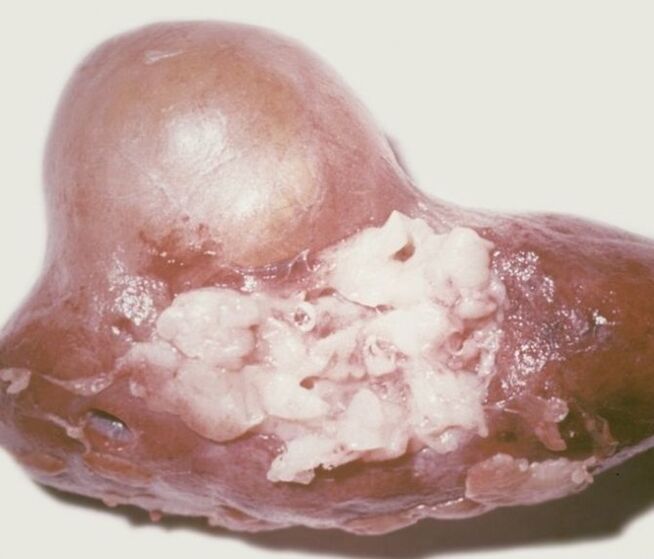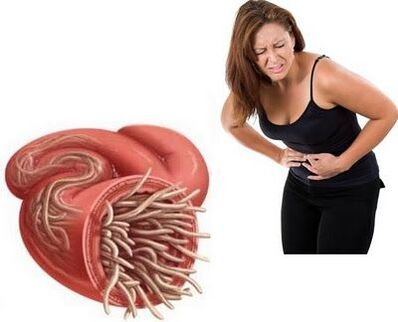Parasites - this is the name of one of the most common infectious diseases.Today, about 300 parasites are known, it is a danger to humans, including a deadly human being.On the territory of the European continent, this is just a few dozen parasites (medical name - Helminthias, Helminthic invasion).
The largest part of parasites related to humans is common in tropical and subtropical climates, as well as the level of socio -economic development and low sanitation.
What is dangerous parasites

Parasites in the human body can affect almost all internal systems.The extent of damage depends on the type of helminth, the time of the disease, the initial health condition.The sooner the diagnosis of the specific helmet invasive is set, the more opportunities to quickly escape the parasite.That is why it is important to promptly diagnose the invasive status with parasites and perform all stages of treatment.
Almost any variant of helminths, especially for a long time, causes significant harm to the human body.Hlybon's invasion is the reason for the delay in the development of psychological motivation in children of all ages, significantly reducing performance and storing life in adults.
Regardless of a person's age, Heelminthic's invasion contributes to allergies, reduces the ability of the immune system to combat infectious diseases and other diseases, in addition, the effectiveness of preventive vaccine treatment is significantly reduced.
The cleaning of the parasitic body in rare cases occurs naturally, in most cases, a specific treatment is necessary for this in a certain diagram.
What are parasites

The parasite (they are also worms or worms) is a large group of complex organized organisms that can exist for a long time in operating state under different conditions.An important feature is the ability to exist in another living organism (human or animal), called "aggression".
Currently, many types of parasites in the human body are known.The most common classification of parasites depends on their external structure and features of the life cycle.
With biological characteristics, all parasites are divided into 3 large layers:
- Round worms (they are also nematodes), for example, trichinella, ankylostoma, battery, Ascaris;
- Ribbon worms (they are also cestodes), for example, aleococcus, echinococcus, broadband, t -tape, pork and dwarf;
- Supers (they are also tremontodes), for example, Opistorch, Fasciol, Clonorch.
In addition, like many other diseases, different parasites:
- by severity;
- By leading syndrome, that is, the system of organs is larger than the larger level;
- by the presence and nature of complications;
- By the possible results of the disease.
Features of parasites
Development phase
Parasitic diseases are characterized by a number of differences related to the characteristics of parasites and their life cycle.
The number of adults in the human body does not increase, as long as there is no new infection.To carry out the life cycle, most parasites require changes in the living environment (animal body, soil, etc.).
For any parasite, development stages are typical.Throughout the life cycle, Helminth surpassed a number of continuous development development stages.As a rule, parasitic eggs are turned into a larvae and further into an adult individual.The opposite development does not occur, the egg cannot immediately go to the stage of an adult.
The parasite enters the human body at a period of its life cycle, and goes out at a different stage.It is at this time, the non -treatment of the actual people of parasitic diseases in people involved.That is, it is impossible to be infected with parasites when exposed to direct contact with infected people.
The paths of penetration can enter the human body
With many types of parasites, one person may meet anywhere - they cannot see their eyes.The following options are likely:
- The mouth of the mouth, meaning that there is no completion with personal hygiene, using dirty products or not being treated with heat;
- The pathway through the skin, meaning that the larvae or adults of parasites enter the human body through skin damage, when exposed to water or soil, with the participation of insects causing blood.
Most parasites affect the human body only living in the adult period, mainly in the digestive tract.These are intestinal parasites (helminths).In their turn, they were divided into 2 groups by some features.
The intestinal parasites of the first group enter the human body as an egg.In the digestive tract, they are turned into an adult individual.The movements of such parasites (worms, broadband ribbons, pork and tapeworms) are limited to different parts of the gastrointestinal tract.
Representatives of the second group (their larvae or eggs) perform longer and complicated migration according to different tissues and organs of the human body.Only then an adult individual of the parasite was formed.It is clear that the symptoms of such parasites are much more diverse, because the movement process is related to significant changes in the body.
The parasite, at the stage of an adult or larvae placed outside the gastrointestinal tract is called tissue.If in the human body, a parasite only exists at the stage of the larvae, one person to him is an ecological dead end, which Natmin cannot leave.
Characteristics of the parasitic life cycle
To know how to eliminate parasites in the body, it is necessary to show their life cycle in common terms.This knowledge also helps prevent parasites from entering the human body.
According to the features of the life cycle, all parasites are divided into:
- Geographic parasites;
- Helminthoses infectious;
- Bio Heelminthia.
To carry out the life cycle of the GeO parasite (Vlasov, a person not), it is essential that eggs are a certain amount of time in the soil.In the future, with direct contact with dirty soil, the use of vegetables is washed, through dirty hands, parasites penetrate the human body.
In the contagiosteal parasite (roundworm, Tabbells dwarf), all development stages only occur in the human body, without changing in the environment.Only parasitic diseases are transmitted directly from one person to another.It is also possible that, especially in childhood, cases of regeneration, that is, from themselves in case of not complying with hygienic rules and skills.
The most complex life cycle in the biosome process is set out.A prerequisite for their life cycle is the presence of an intermediate host.A person may be an intermediary or the last master.For example, with Echinococcosis, one is an intermediary host, and dogs and cats are the last.In the case of a tusherinchosis, on the contrary, the representative of the cattle is an intermediary host, and one is the last.
Symptoms of parasites
On the one hand, the clinical signs of parasites are determined by the dominant damage to a specific organ, on the other hand, they have common characteristics that allow us to distinguish the acute and chronic phase of the parasite.
The acute phase of a parasitic disease corresponds to the movement phase of the growing helminth.It is manifested by clinical signs such as allergic and toxic reactions in general (ascariasis, schistosomosis, fasciolesis, trichinellosis).
The immune component has a significant weight in the development of the acute parasitic stage, forming a certain pattern of clinical images and some similarities with other immune reactions with non -infections - atopic dermatitis and other.
The hidden period with most parasites is a few weeks, reduced to 7-10 days with a huge and prolonged infection version with poor intensity.
The main symptoms of parasitic diseases are as follows:
- Increase body temperature - from Subfebrile to very high;
- Muscle and joint pain, duration and intensity;
- The formation of a rash on the entire skin surface, in size and intensity, accompanied by itching skin;
- Significant of the skin and subcutaneous tissue, less often - mucous membranes;The most typical for Trichinellosis, has given the disease a common name typical Buffy Buffy;
- The development of lung syndrome, namely night cough, Astmitoid state, forming pneumonia with the center of migration of the lesion;
- The development of abdominal syndrome, characterized by moderate abdominal pain, loose stools without impurities of mucus and blood;
- In serious cases, damage to the central nervous system and the heart are observed;
- A special feature of helminths is that the changes in peripheral blood: leukemia pronounced and hypnotusemia significantly (up to 30-40%).
In the treatment at the stage of acute phase of drugs from parasites in the human body, the most effective.
At the stage of the chronic phase of parasitic diseases, harmful effects are determined by mature parasites.The adverse effect for the human body is related:
- Harmful and less allergic effects;
- Mechanical lesions for parasitic tissues (for example, liver echinococcosis);
- the absorption of nutrients, violating metabolic processes, the development of anemia and viscosity;
- Serious anemia;
- Increase a person's discomfort and irritation;
- Secondary infection and dysfunction, the weight of the process of infectious diseases and other infections, as well as pregnancy.
The existence of individual parasites is different - from a few days and weeks (cutting machines) to many years.After a parasitic disease, it may be re -infected, as immunity is not formed.Therefore, the body cleansing an hour from the parasite that does not protect against a repetitive period of the disease.
Treatment of parasites

Treatment with classical drugs of parasites in the present has achieved significant success.The introduction to clinical practice of compounds of benzimidazole and imidazole allows successful treatment of many types of helminthias.
These drugs have a wide exposure spectrum, small toxin with a brief treatment process, for adults and children convenient to use.The corresponding age of the dosage of the drug should be observed.
How to clean the body of a specific parasite, the treatment regime to choose and which drug is determined by the doctor.Do not prevent helminths in personal initiatives, because of drug addiction developing, which means reducing their effects.
Cleaning parasites
With parasites, treatment with folk remedies is no less common compared to the means of traditional medicine.Supporters of natural tools for parasitic diseases focus on the safety and popularity of that therapy.There are many prescriptions of traditional medicine, which allows you to cope quite effectively with parasites in the human body.The following options to eliminate parasites in the human body most famous:
- Coriander and pumpkin seeds as a preventive and treatment agent for parasites;
- Alcohol on Chanterelles combined with white mushrooms;
- A decree of the catheter;
- TinCTure of green walnuts.
Any folk remedies for parasites should be taken according to the formula and clean hands.Before choosing a specific formula, it is important to ensure that a person is not allergic to the ingredients as part of the drug.
How to protect yourself from parasites

It is easy and difficult at the same time.Some simple rules will help minimize the risk of infection with any parasite:
- Carefully washing hands;
- The right habit of using a set of individual dishes;
- Thoroughly handle any meat and heat fish, with careful use of fish and salty fish and meat;
- Treat vegetables and fruits with boiling water (after washing in flowing water);
- Always wash your hands with soap after communicating with animals (even in water).
Parasites infection at all ages is an unpleasant problem, but completely removed early treatment.






































